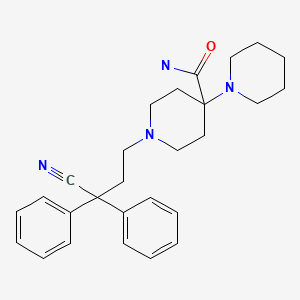Attribution Statement: LactMed is a registered trademark of the U.S. Department of Health and Human Services.
NCBI Bookshelf. A service of the National Library of Medicine, National Institutes of Health.
Drugs and Lactation Database (LactMed®) [Internet]. Bethesda (MD): National Institute of Child Health and Human Development; 2006-.
CASRN: 302-41-0

Drug Levels and Effects
Summary of Use during Lactation
Piritramide is not approved for marketing in the United States by the U.S. Food and Drug Administration, but is available in other countries. Limited data indicate that the amounts of piritamide in colostrum is very low after use of intravenous piritamide by patient-controlled analgesia.
Maternal use of oral opioids during breastfeeding can cause infant drowsiness, which may progress to rare but severe central nervous system depression. Newborn infants seem to be particularly sensitive to the effects of even small dosages of narcotic analgesics. If piritramide is required by the mother of a newborn, it is not a reason to discontinue breastfeeding; however, once the mother's milk comes in, it is best to provide pain control with a nonnarcotic analgesic and limit maternal intake of piritramide to 2 to 3 days at a low dosage with close infant monitoring. If the baby shows signs of increased sleepiness (more than usual), difficulty breastfeeding, breathing difficulties, or limpness, a physician should be contacted immediately.
Drug Levels
Maternal Levels. Ten women who had received piritamide intravenously by patient-controlled analgesia during the first 48 hours following a cesarean section had drug concentrations measured in their colostrum. The timing of samples was not reported. Six of the women had concentration of piritamide below the lower limit of quantification (<30 mcg/L). Of the other 4 women, the highest concentration was 75 mcg/L.[1]
Infant Levels. Relevant published information was not found as of the revision date.
Effects in Breastfed Infants
Relevant published information was not found as of the revision date.
Effects on Lactation and Breastmilk
Relevant published information was not found as of the revision date.
References
- 1.
- Van Eeckhaut A, Vanfleteren P, Van Schoors J, et al. Quantification of piritramide in human colostrum. J Clin Pharm Ther 2017;42:306-10. [PubMed: 28295465]
Substance Identification
Substance Name
Piritramide
CAS Registry Number
302-41-0
Drug Class
Breast Feeding
Lactation
Milk, Human
Analgesics, Opioid
Narcotics
Disclaimer: Information presented in this database is not meant as a substitute for professional judgment. You should consult your healthcare provider for breastfeeding advice related to your particular situation. The U.S. government does not warrant or assume any liability or responsibility for the accuracy or completeness of the information on this Site.
- User and Medical Advice Disclaimer
- Drugs and Lactation Database (LactMed) - Record Format
- LactMed - Database Creation and Peer Review Process
- Fact Sheet. Drugs and Lactation Database (LactMed)
- Drugs and Lactation Database (LactMed) - Glossary
- LactMed Selected References
- Drugs and Lactation Database (LactMed) - About Dietary Supplements
- Breastfeeding Links
- PubChem SubstanceRelated PubChem Substances
- PubMedLinks to PubMed
- Review Hydrocodone.[Drugs and Lactation Database (...]Review Hydrocodone.. Drugs and Lactation Database (LactMed®). 2006
- Review Oxymorphone.[Drugs and Lactation Database (...]Review Oxymorphone.. Drugs and Lactation Database (LactMed®). 2006
- Review Fentanyl.[Drugs and Lactation Database (...]Review Fentanyl.. Drugs and Lactation Database (LactMed®). 2006
- Review Methadone.[Drugs and Lactation Database (...]Review Methadone.. Drugs and Lactation Database (LactMed®). 2006
- Review Hydromorphone.[Drugs and Lactation Database (...]Review Hydromorphone.. Drugs and Lactation Database (LactMed®). 2006
- Piritramide - Drugs and Lactation Database (LactMed®)Piritramide - Drugs and Lactation Database (LactMed®)
Your browsing activity is empty.
Activity recording is turned off.
See more...
